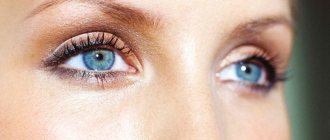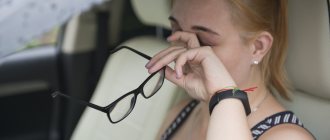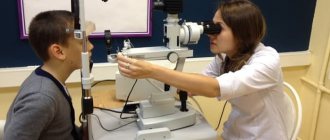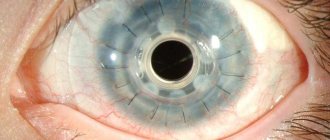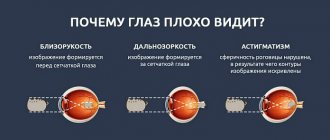Fact #1: Size matters.
The human eyeball does not have the shape of a regular ball, as is commonly believed, but a sphere slightly flattened from front to back. The weight of the eye is approximately 7 g, and the diameter of the eyeball is the same in all healthy people and is equal to 24 mm. It may deviate from this indicator in diseases such as myopia and farsightedness. Fact #2: eye color
All children are born with blue-gray eyes, and only two years later do they acquire their true color. Human eyes come in different shades, depending on the concentration of melanin pigment in the iris of the eyeball.
The rarest eye color in humans is green. Red eyes are characteristic of albinos and are explained by the complete absence of coloring pigment and the color of the blood vessels visible through the transparent iris.
Each person's iris is unique, so its pattern can be used for identification just like fingerprints.
Symptoms of myopia from 3 to 6 diopters
Myopia usually develops in childhood and adolescence.
Therefore, parents of children should carefully monitor their child’s behavior while preparing lessons, as well as when watching TV. The disease always occurs with pronounced symptoms. How does this manifest itself? Symptoms of myopia 3-6 diopters:
- the impossibility of a detailed examination of objects located at an average, long distance;
- rapid eye fatigue, headaches during visual stress;
- the desire to squint to better view distant objects - squinting, incomplete closure of the eyelids and reflex constriction of the pupil, reduce the viewing area, allowing direct rays of the light flux to focus on the retina, which somewhat improves visual acuity.
Also pay attention to what your child’s vision is like at dusk. In the presence of pathology, it weakens significantly in the evening. If you notice that the child, when examining objects, tries to move them closer, squints when looking into the distance, you need to visit a doctor to confirm or refute the diagnosis.
Hypermetropia is considered a very serious disease because it is very difficult to recognize at the initial stage. It was said above that the first degree can hardly be diagnosed, since it is accompanied by minor symptoms in both adults and children. Children become irritable, lose perseverance at school or in classes, and get tired quickly.
In adults, hypermetropia is also associated with constant fatigue, and when reading, patients note that text up close appears blurry. If you find any signs in yourself or your child, do not rush to panic or make a diagnosis that may turn out to be false, especially do not buy eye drops, lenses or glasses.
Make an appointment with an ophthalmologist and ask him to conduct a thorough diagnosis, examining the shape of the eyeball and determining the degree of farsightedness, if any. At the initial stage, correction with optical products is prescribed, which can significantly reduce the development of farsightedness and the occurrence of possible complications.
Fact #3: Light and Dark
Different types of photoreceptors in the retina are responsible for a person's ability to see in light and in darkness. Rods are more photosensitive and help us navigate in the absence of sufficient lighting.
Disruption of their functioning causes the development of so-called night blindness - a disease in which a person sees very poorly in dim lighting.
Thanks to cones, a person distinguishes colors. The human eye has an average of 92 million rods and 4 million cones.
What is minus five vision?
A pathological change in the length of the eyeball towards increase is called myopia or myopia. Myopia comes in several degrees:
- Weak – slight increase in the apple, up to three diopters;
- Medium – a significant increase, up to six;
- High – more than six.
Myopia develops in childhood, usually the first manifestations begin around 7 years. There are several reasons for this violation:
- Genetics - if one or both parents have minus five, most likely the child will also have myopia;
- Weakness of accommodative muscles - leads to stretching of the eyeball;
- Increased stress on the eyes - with the start of school, the stress experienced by the little person increases;
- Unfavorable environment - unbalanced diet, lack of vitamins, insufficient lighting when working at school and at home;
- Computers and digital devices - many children spend a lot of time uncontrollably on gadgets, overloading their eyes.
Minus five is moderate myopia. People with minus five vision, finding themselves on the street without correction means, cannot distinguish faces at a great distance. It is also difficult to see the bus number and letters in store windows. Acquaintances are recognized solely by their manner of movement - the contours look blurry. Reading is difficult - you have to hold the book very close to your eyes. A child with minus five vision cannot see from the board, even from the first desk. In the absence of correction, learning suffers.
Fact #4: Upside down
The image of objects projected onto the retina of the eye appears upside down. This optical effect is similar to the projection of a lens in a camera. So why do we see the world around us normally, and not upside down?
This is due to our brain, which perceives the image and automatically brings it to its normal position. If you wear special glasses that reverse the image for some time, then at first everything will appear upside down, and then the brain will adapt again and normalize the optical distortion.
Why myopia occurs - causes of refractive error
If a person was born with normal vision, then it cannot change overnight. This is preceded by a certain period of instability, such as with false myopia. Or vision is affected by processes associated with a hereditary factor. When one or both parents suffer from myopia, the child is at risk.
What should children's vision be like? Normally, children are born farsighted, and the shape of the eyeball is shortened. Congenital myopia, more than 3-6 diopters, implies an elongated eyeball. When refracted, light rays do not reach the retina. Such disorders are dangerous for the overall development of children, since the formation of the visual analyzer occurs incorrectly.
Most often, myopia of 3-6 diopters is diagnosed in primary schoolchildren and adolescents. It is believed that myopia of this form is associated with increased visual stress, but in most cases a predisposition to the disease is recorded. Predisposition can be determined in children during routine medical examinations and then the child’s exercise and rest regime can be completely reconsidered.
Experts and their research show that there are essentially two key causes of farsightedness: either a short eyeball or weak refractive power of the eye. For some people, these two factors occur together. In addition, doctors talk about some other reasons:
- the lens is too far away;
- there is a transformation of not only the shape, but also a change in the refractive power of the lens;
- dilation of the pupil or accommodative spasm.
In addition, increased pressure inside the eyeball is another factor that can act as a provocateur for the development of the disease. It is also worth mentioning senile hypermetropia and presbyopia. It is caused by the general aging of the body: the muscles that hold the lens weaken, as does the ability to focus.
Not seeing a friend at a bus stop, getting on the wrong minibus, losing something and looking for it for a long, long time, etc. This is what it means to have vision, 3. It becomes impossible to live without glasses.
There are three levels of myopia:
- Low myopia, vision up to -3 (comfortable stage).
- Moderate – ranging from -3 to -6 (uncomfortable, but acceptable).
- High degree – from -6 and more (complex myopia, dangerous).
Why does the optical power of the eye not correspond to its length? There are several reasons for this:
- High eye pressure can cause a rare disease, juvenile glaucoma. Develops in babies in the prenatal state. Reaches up to 5-6 diopters.
- 10% of people suffer from weak sclera (connective tissue). As a result, myopia not only develops rapidly, but develops mega-rapidly. Especially against the background of reduced immunity. It all starts at the age of three and can last up to 35. Vision reaches 20-25 diopters with an “apple” length of 32 mm. This is a very unfortunate case. Heredity plays the main role here.
- In most people (65%), myopia develops due to overwork of the eye muscles. Poor nutrition, poor light, infrequent blinking when reading, watching videos leads to elongation of the eye.
- The last two factors can be present simultaneously. This will be a mixed type of myopia. The length of the eye is approximately 26-27 mm, vision is 7-8 diopters.
The following may also contribute to reduced visibility:
- head injury,
- high intracranial pressure,
- other eye diseases (strabismus, etc.),
- lack of vitamins, consumption of alcohol, nicotine, drugs.
- Knowledge of the degree of development of the disease affects the tactics and success of treatment.
Fact No. 9: eye diseases
According to statistics from the World Health Organization, almost 300 million people in the world are familiar with the problem of visual impairment. And 39 million of them suffer from blindness!
As a rule, vision loss is caused by age-related cataracts, and advanced diabetes is also increasingly being cited as a cause.
Among the diseases of the visual organs that can be corrected with glasses, contact lenses or surgery, the most common are farsightedness, nearsightedness and astigmatism. In order not to miss the first signs of the disease, it is necessary to visit an ophthalmologist for preventive purposes once a year.
How does a person with vision of 3-6 diopters see?
In the world of illusions, it is in this state that a myopic person with vision of -3 resides. He perceives objects not as they really are. The outlines of figures at a distance become unclear. Large objects appear small and vice versa.
The skin on people's faces appears smooth, almost perfect. To some extent, with myopia, the world is transformed. Small details and roughness disappear. The surroundings become blurry. It’s like turning down the sharpness in a photo or shading the contours of the picture.
For comparison:
- At -1, a person practically does not feel discomfort. He just doesn't see very far.
- At -2, it is difficult to distinguish large inscriptions at a distance of 40-50 meters.
- Vision -3 turns near into distant. Text on a computer screen, for example, can no longer be read.
| A defect in the eye in which light rays are focused not on the retina, but in front of it, is called myopia. The longer the eyeball, the worse a person sees far away. The higher the level of myopia, the more side effects appear. At vision -3 they become noticeable. |
The disease progresses in any case. This is especially dangerous in childhood. Then vision deteriorates rapidly because the child grows quickly. Computers, tablets, phones and other gadgets aggravate the disease by placing excessive strain on the eyes. The danger is a decrease in vision by more than 1 diopter per year.
Myopia of 3 or more diopters - how is it? Moderate myopia - from 3 to 6 diopters - is a common form of refractive error. With this pathology, a person’s vision does not allow him to see objects located in the distance. They seem fuzzy, blurry, and looking at them without glasses can cause headaches and dizziness.
Patients, knowing that they have vision, for example -6, try to find out how much it will be as a percentage, although percentages and diopters are different things. Each line of a special table is taken as a conditional 10% of vision. And diopters are a correction option with which you can achieve the best possible vision. Some people need lenses of -1.5 to see 10 lines, while others need, for example, -6 diopters.
How myopia manifests itself from 3 to 6 diopters:
- objects located close are clearly visible, but distant ones lose their outlines, become unclear, blurred, the stronger the myopia, the worse the visibility of distant objects;
- deterioration of twilight vision - in the evening or insufficient daylight, a person’s vision with 3 diopters or more becomes worse due to dilation of the pupils with poorly developed peripheral parts of the retina;
- constant feeling of eye fatigue, decreased performance, headaches, increased fatigue, asthenic syndrome.
For patients whose myopia is from 3 to 6 diopters, vigorous physical activity is contraindicated; it should be moderate. In the absence of necessary preventive measures, the disease tends to progress. And myopia of 6 diopters is a serious refractive error, dangerous with a large number of complications.
People receive most of their information through their visual organs. Just one glance at an object can provide comprehensive information about it.
With myopia, a person cannot normally see distant objects, which causes certain inconvenience.
Vision minus 1 means only a slight deviation from the norm, but even in this case, corrective treatment is required.
Minus 1: diagnosis
People who have poor vision are diagnosed with myopia. Doctors say that such vision problems are observed in 30% of the entire population of the planet. However, diseases of this kind are more common in developed countries.
To understand why such problems arise, it is worth understanding on what principle the visual organs work.
So, absolutely everything that a person sees around him is just rays of light reflected from the objects around him. These rays are perceived by the sensitive element - the pupil.
It collects rays and focuses them on the retina, this part transmits a signal to the nervous system, and then to the brain.
Normally, the point where light rays are collected lies directly on the retina. Thanks to this structure, a person sees a clear picture of the world around him. In people with myopia or negative vision, the rays are first focused in front of the retina and then scattered again. Because of this, the picture that reaches the brain turns out blurry.
The severity of myopia depends on the distance between the focal point itself and the retina. Each millimeter of distance between these two points is counted as three diopters.
In people with minus 1 vision, the image falls approximately 0.3 mm from the retina. If vision is minus 2 or minus 3, then this distance increases accordingly.
Treatment method for grade 3 myopia
| Degree | Description |
| Weak | Vision indicators minus 3 diopters. Its sign is blurry images in the distance |
| Average | From minus 3.5 to minus 6 diopters. In addition to a decrease in visual function, dystrophic disorders occur in the fiber, stretching and thinning of blood vessels is observed |
| High | Visual acuity is below minus 6 diopters. It is characterized by the development of serious pathological processes in the visual system: thinning of blood vessels and fiber. At this stage, the person retains the ability to see fingers at arm's length, but when reading, vision deteriorates noticeably |
Some unscrupulous ophthalmologists propose to fight grade 3, just like grade 1, saying that the nature of the disease is the same, and it is only appropriate to increase the intensity of restorative measures.



